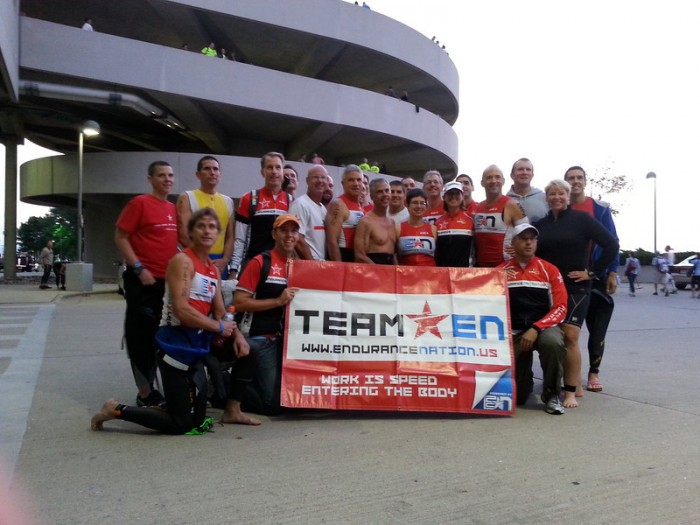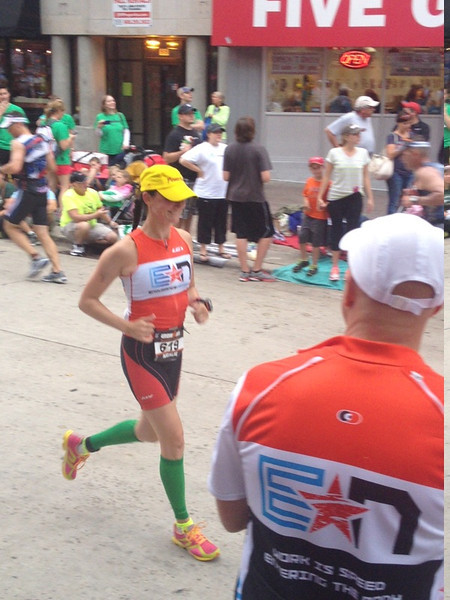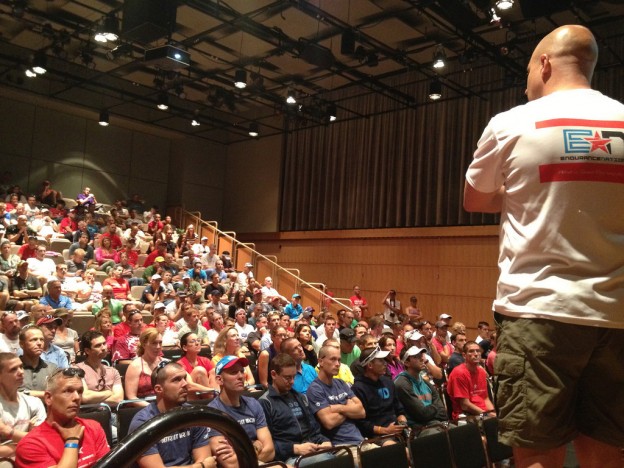Endurance Nation has a long history on the Ironman® Wisconsin course: Coach Rich raced the event in ’02, ’04, and ’11, with a PR of 10:05, has conducted 10 training camps on the course, has been on hand for the race pretty much every year, and has coached hundreds to the Wisconsin finish line. Finally TeamEN has had 18 to 50+ athletes at the race every year since 2008. We’d like to share that experience with you with these consolidated tips and resources specific to the Ironman Wisconsin course:
Weather
Ironman Wisconsin has seen a variety of weather over the years — perfect in 2002, blistering hot in 2005, cold and rainy in 2006, and everything in between. In short, be prepared for anything, planning for a hot day…and then be pleasantly surprised if the weather is perfect.
Timing of the Event
The timing of an event should the #1 criteria you use for selecting what Ironman® to train for and race — not hills, not weather, not water temperature, but does rather the timing of the event work for you. Will you have cooperative weather and hours of daylight available for training, especially in the last 8-10wks of your work up? Examined under these criteria, Ironman Wisconsin is a good race, timing-wise for nearly everyone in the US. More importantly, the date of the race facilitates the split-season approach we use with our team. Endurance Nation athletes racing Ironman Wisconsin will likely schedule their season like this:
- Late October thru mid February: OutSeason® training
- March thru May to early June: training for and racing a May to June Half Ironman event.
- Mid-June: begin officially training for Ironman Wisconsin.
Internally on the team, we only place our athletes in the last 12 to 14 weeks of our internal 20 week full distance training plan. The schedule above lets us keep their volume as low as we can for as long as we can, so we can keep the intensity up and make them much faster athletes. More importantly, this split season approach keeps their heads out of a space where they are training “for” Ironman Wisconsin. Instead, their heads are only in that space for about 12 weeks, helping them conserve mental energy and Spousal Approval Units (SAUs) across the season, to be applied closer to the race.
The Venue
Travel costs and logistics: Madison has good size regional airport and of course Chicago OHare and Midway are only about a 2.5hr drive from the city. Lodging: as the state capitol and home to the University of Wisconsin, Madison has wide variety of hotels accommodations. However, prime location hotels do book very early and if the Badgers have a home game that weekend, expect everything to book even sooner. That said, there are many options 10-20 minutes outside of town so don’t be afraid to book something other than downtown. Parking: tons of public parking available, so this is a non-issue. However, expect some confusing one-way streets in the area of the capitol building, as well as construction. Always, always construction… Dining: Madison is one of the best-eating Ironmans on the circuit. Tons of options. Now, let’s get on with the race!
The Swim
Practice Swims: the course won’t be setup until Saturday afternoon but you’ll be able to swim in the lake before race day. Just start from the ski jump, swim along the swim course (shore is on your right) for a bit flip it and come back. The Swim Start: Ironman Wisconsin has one of the more sane mass swim starts. What we’ve found is that the faster swimmers line up right on the buoy line. Everyone else tries to get far away from these people, lining up closer to shore, and actually leaving the center of the start line relatively uncrowded. We recommend starting near the ski jump. The Course: the Wisconsin swim is a one loop affair. As such, the third leg of the swim, after the second turn, is very, very long so be prepared. The Temps: the water has been warm-ish the last few years but we can still pretty much guarantee the swim will be wetsuit legal.
The Four Keys of Wisconsin
Join Coach Rich in Madison, as he teaches how you to race every inch of the course, in this 90′ presentation at the Overture Center for the arts!
The Transition
Upon exiting the water and having your wetsuit stripped, you then run up the “helix.” Think spiraling ramp up a parking deck. Everyone has to do it, it’s no big deal, and the spectators lining the helix will make it an experience you’ll never forget! The changing tent? Think huge convention center room with convention center chairs. You then exit, run to your bike, mount at the top of the opposite helix and ride down it. Don’t worry, everyone runs the same distance, and don’t sweat riding down the helix. Again, think parking garage ramp and just take your time.
The Bike
Go here for the full course map. Go here for Coach Rich’s video on the bike course The Wisconsin bike course, in our opinion, is the most challenging on the US Ironman® circuit, in our opinion, what truly separates one course from another isn’t total elevation gain, winds, etc, but rather how often it forces you to make a decision. Lots of little good decisions create a good day. Lots of little bad decisions add up to create a very bad day. At Wisconsin you are making decisions for the entire 112 miles. Flat, false flat, up, down, left, right, head/cross/tailwind, do I shift/not shift into my small/big ring? Do I power or noodle up this little/big hill? On the Wisconsin course you are never doing any one single thing for longer than about five minutes. This creates the opportunity to make a lot of little (and big) mistakes that express themselves somewhere on the run. Wisconsin, more than any other US course, rewards the smart, patient, and disciplined cyclist. Strength can be a liability on this course, if you don’t know how to use properly. Read: The Triathlon Magic of Riding Steady, Parts I and II <– VERY IMPORTANT!
The Ironman Wisconsin Bike Course
Macro: it’s very important that you engage the terrain in front of you using our hill climbing guidance in that blog post above. There are so many hills, grade changes, and terrain features on this course that it’s not very useful to drill the course down to this hill, that hill, etc. Rather, get your mind right about how you should approach the terrain you’re on right now, using that guidance above. Micro: that said, let’s divide the course into sections and discuss how to approach each: The Stick, Out: from the start of the bike to the top of Valley Road
- Easy, JRA (Just Riding Along), and prepared for everyone else to be hammering. Don’t join them!
- Note the climbing from about mile 7.5 to mile 10, particular the hill at mile 10. People will crush this, but you…
- Stay on the gas on the downhill and do your thing on the gradually downhill terrain into Verona to the top of Valley Road, where we consider the bike loop to officially start as you enter that classic Ironman Wisconsin farming country.
- Once you’re at the top of Valley Road, you may now begin to officially ride the bike, dialing in your effort for the day.
 Messerschmidt Road: this is where you’ll first be presented with the rolling hills on which our hill climbing guidance is so critical. Get your mind right about doing the right thing while everyone else around you does the wrong thing. Gain confidence in your plan as you watch others around you make critical mistakes. The Loop, from Messerschmidt to Cross Plains to the bottom of Old Sauk: again, you’re smartly engaging the terrain in front of you and ignoring everyone else, and setting yourself up for The Three Hills (more below). Be mindful of:
Messerschmidt Road: this is where you’ll first be presented with the rolling hills on which our hill climbing guidance is so critical. Get your mind right about doing the right thing while everyone else around you does the wrong thing. Gain confidence in your plan as you watch others around you make critical mistakes. The Loop, from Messerschmidt to Cross Plains to the bottom of Old Sauk: again, you’re smartly engaging the terrain in front of you and ignoring everyone else, and setting yourself up for The Three Hills (more below). Be mindful of:
- The climb into Mount Horeb: this is one of the beefier climbs on the course but it’s often overlooked.
- Rollers on Witte Road: you’ll be tempted spike your effort and roll over these…don’t even try it, you will fail.
- Garfoot Rd, Part 2: sharp right, left, right (expect gravel on the right side), sweeping left, done. Just be safe, you’ll be fine.
- Stagecoach: flat and fast…but very rough. Stay on your effort and check your fillings at the end.
The Loop, the Three Hills – you’ve surely heard tales of these monsters, but here’s the deal:
- Old Sauk: about .8 miles at 5-6% grade, shaded, bends to the right so you can’t really see the top until you’re there.
- Timberlane: about .2 miles at 9-11% grade. Be sure to shift to your small ring on the downhill approach to this kicker. After this hill it’s flat, fast, then a very fast downhill into a sharp left. Be careful of this left. Then a bit more to the bottom of…
- Midtown: about .6 miles at 5-6% grade, with a false flat at the top.
- Throughout, expect huge Tour de France-style crowds. Do not put on a show for these people!
The Loop, from the top of Shady Oak to Verona – this is a generally downhill and fast section back to Verona. Focus and maintain your effort here while others, having blown themselves up on the Three Hills, recover. Be careful at the aid station in Verona, as there is often a big speed differential in here, especially on Loop 2, between faster and slower cyclists. Faster cyclists, consider skipping this aid station and picking up bottles at the mile 99 aid station, on the final climb on the Stick back. The Stick, Back: note the climb at mile 99-100, which is that mile 10 downhill referenced above. After this it’s generally downhill back to town but expect a headwind.
The Bike: Putting It All Together
- The Stick, to the top of Valley Road: JRA, warming up, watching everyone else crush themselves.
- The First Loop:
- Hill climbing guidance on Messerschmidt — dial in your head!
- Exercise ^this^ through the remainder of the Loop, taking advantage of the opportunity from Shady Oak to Verona, and pacing yourself so that you can on…
- The Second Loop:
- Ride the section from the bottom of Old Sauk through Verona stronger than you did on the first loop.
- Have an answer for the hill at mile 99-100 and expected headwinds back to Madison.
The Run
The complete run course map is here Go here for Coach Rich’s video on the run course The Wisconsin run course is two laps, winding, urban, mostly flat and not nearly as challenging as the bike course. There are two sorta-significant hills on the course:
- Observatory Drive, at about miles 8 and 18. A couple of rollers, then a short, steep, switchback downhill that rolls into State Street.
- State Street, at the end of each lap. Actually, you need to climb up to the Capitol before heading to the end of each lap and, depending on how you’re feeling, that climb can feel like it starts on State Street…or much sooner! Either way, State Street is packed with spectators to cheer you on!
The rest of the run course has a little of everything: turns, roads through campus (and even a lap of the Camp Randall football field!), a shaded dirt walking path next to the lake, hundreds of spectators on State Street, and more. In fact, there will likely be only about 400 yards on each lap where you will not be cheered on by spectators. The key is to dial in your effort, running smart, through the high-energy sections near the capitol, on State Street, and in the early sections on the bike paths. It’s very easy to get caught up here in the excitement and the actions of others…who are nearly all running much faster than they should be.
What Can My Family Do on Race Day? If they want to see you on the bike, the town of Verona puts on a neat family festival they can attend while they wait for you to come through town twice. The race should offer shuttles to Verona. Another option is to take one of many county roads to the hilliest hills on the course (Old Sauk, Timberlane, Midtown) and contribute to the Tour de France vibe on the climbs. If they want to stay in Madison while you ride, downtown Madison, and especially State Street, offer a range of activities. In fact, if you look at the run map, you’ll see that your family can station themselves near the ends of State Street and only walk a couple blocks to catch you coming and going many times.
Additional Learning —
The Four Keys of Wisconsin
Join us for this FREE talk, as Coach Rich teaches you how to race every inch of the Ironman Wisconsin course! 
TeamEN Race Reports and Podcasts:
We’ve found race reports to be extremely effective tools to teach our athletes how to race: TeamEN post their race reports, as well as their race and race rehearsal plans, in our forums for peer review from their comrades. The result is a very rich, team-wide knowledge base of race execution tips and a culture of athletes helping athletes learn now to race better.
Endurance Nation Blog: Ironman® Wisconsin Race Report Archive
Endurance Nation Podcast Channel: Ironman® Wisconsin Race Report Podcast Interviews
IRONMAN® is a registered trademark of World Triathlon Corporation, is not affiliated with Endurance Nation®, and does not endorse or sponsor our products, materials or events.






Leave a Reply